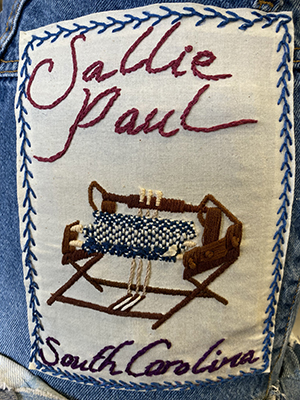Sallie Paul
“The white folks make their own cloth right there on the plantation. They had a loom house, but my mother had a loom right to her own door. Sometimes, she would weave piece for the white folks and then she weave for herself. It was sure a time, to speak about, when they had one of them quiltings on the plantation. Didn’t do nothing but quilt. Quilt and dance then play some sort of something after they would get done.They had plenty of scraps to make their bed clothes with, because the Missus would save scraps for them. My God a mercy, I tell you, slavery time was something. That been a day. Colored people didn't have no more privileges in slavery time then these people got now in this here chain gang.” – Sallie Paul
 LaNiyah Grovell ’27
LaNiyah Grovell ’27
In 1865 slavery was abolished in the United States “except as punishment for crime.” The 13th Amendment did not stop Jim Crow laws from proliferating throughout the South, making it legal for people of color to be incarcerated for minor infractions that did not apply to whites. After men, women, and children were arrested for reasons like being out after curfew or daring to vote, they could be sent to prison and “leased out” as workers to privately owned businesses, like cotton plantations.
This system of “convict leasing” created a new supply of cheap labor to replace the free slave labor that the plantations had previously needed to make money. As is the same today, incarcerating African Americans was an economic incentive in the for-profit prison system. At Angola Prison in Louisiana, wrongfully convicted men have spoken out against the current day situation. Inmates are paid a few cents an hour to pick cottons in the same fields where enslaved people were forced to work over 200 years ago.
Artist Winfred Rembert lived this history. Born in Georgia in 1945, he was incarcerated under Jim Crow laws when he was just eight. In the 1960’s he joined the Civil Rights Movement and was arrested for peacefully protesting. One year of his teenage life was spent in jail without being charged. After attempting to escape from this horrible situation, he was sentenced to seven years of hard labor on a chain gang picking cotton. He survived, was released, and became a painter at age 51. His work didn’t sell well until after his death from Covid in 2021- after that prices soared and his works are now exhibited in museums across the nation. “Thank God I’m alive, and while I’m still alive I can talk about it,” Rembert said “I can talk about surviving. I am a witness. And when I die, I didn’t die by the rope. I just died from being an old man.”
Sources
- Federal Writers' Project: Slave Narrative Project, Vol. 14, South Car|lina, Part 3, Jackson-Quattlebaum. 1936.
- How the 13th Amendment Kept Slavery Alive: Perspectives From the Prison Where Slavery Never Ended - Innocence Project
- Unfairly Imprisoned, He Labored on a Chain Gang for Years. Now Winfred Rembert’s Paintings About That Experience Are Selling for Nearly $300,000 | Artnet
